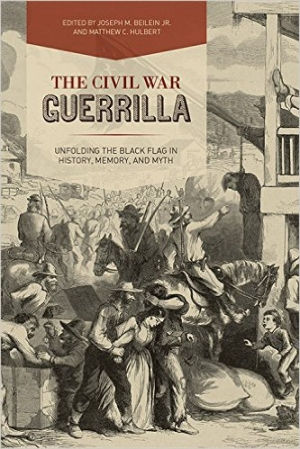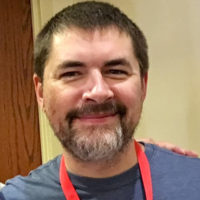
Until recently, the role of the Civil War guerrilla has been largely neglected. Joseph M. Beilein Jr. and Matthew C. Hulbert, however, have done a tremendous service to Civil War history generally and guerrilla conflict specifically in The Civil War Guerrilla: Unfolding the Black Flag in History, Memory, and Myth.
While guerrilla conflict is very much a niche topic, Beilein and Hulbert, and the eight other essayists who contributed to this volume, tell a narrative history every American should be interested in; small-scale guerrilla conflict not only helped to shape the out-come of the Civil War, but also helped to shape the parameters of war-time violence, of which both Union and Confederate guerrillas engaged in – often spurring even more violence.
As they write in the Introduction, “…[T]he black flag has long been associated with the Civil War’s guerrilla conflict. When raised, the flag allegedly signaled a war without mercy, fought to the death, without exception. It was meant to instill terror…it reminded men of their own mortality – of the utter finality and loneliness of death on the battlefield.”
In Violence, Conflict, and Loyalty in the Carolina Piedmont: A Comparative Perspective the contributors convincingly argue that guerrilla conflict “was a product not only of wartime strains and fluctuating power structures but also of antebellum socioeconomic conditions: kinship ties, neighborhood dynamics, political affiliations, and the…ways in which communities functioned. Power relations in rural southern localities, especially in a political sense, were formed long before the attack on Fort Sumter,” they conclude.
For example, in the South Carolina Piedmont, “the upcountry, cotton was certainly king prior to the Civil War…” enabling a “shift from a self-sufficient form of agriculture to the more commercially engaged production of cotton” and the concomitant use of slaves. Conversely, in the North Carolina Piedmont “slavery was far less important.” Textiles and other industries, as well as the railroad, were emerging as the dominant form of economic activity. Additionally, the central Piedmont counties “contained a large Quaker population, and a number of citizens had religious and other ideological concerns about slavery as an institution.”
Such differing political-economic relations shaped the degree to which various communities engaged in guerrilla activity. And, “Differing responses in the North and South Carolina Piedmont developed into contrasting relationships with the nascent southern nation…Respective military enlistment patterns [as well as guerrilla activity] give the historian a clear insight into the divergent loyalties within the two regions.”
The guerrilla conflict, as one contributor notes, served “an ideological as much as a strategic motive.” In what is referred to as “the politicization of the various shadow warriors in the American Civil War,” guerrilla partisans often shared a “collective ideological” rather than “individual, personalized” motive, as they literally battled over the “centrality of slavery and emancipation in precipitating the fullest expression of this form of warfare…”
Additionally, Confederate guerrilla partisans targeted “government officials, federal and county, from postmasters to judges…they hunted office holders or draft board members, who by extension represented the legitimacy of the federal government.” Further, “Unionist legislators, regardless of their stance on slavery, were among the first to become actual targets of irregulars” or guerrillas.
To its credit The Civil War Guerrilla also devotes an illuminating chapter on the impact of Native American insurgent activity against both the Union and Confederate armies. Interestingly, we learn that Confederate officers and soldiers – with approval from Jefferson Davis – hoped to recruit pro-slavery Texans, take New Mexico, and “vanquish California, using its Pacific port to reestablish international trade and subvert the Union blockade” and “Through the instruments of empire honed by American expansionist efforts in the previous decade…the Confederacy could act as a nation on the world stage and maintain its own independence,” while establishing “its dominion over the Union and over the region’s Native Americans.” Fortunately, Native American guerrilla raids helped to squelch this plan for continent-wide domination.
My criticism of The Civil War Guerrilla is the lack of attention on partisan activity that free Blacks or slaves led, initiated or participated in. African Americans, undoubtedly, played an active, leading role in their own liberation from slavery, as soldiers and as guerrillas – as the documentary evidence makes abundantly clear – during the Civil War, and long before.
The Civil War Guerrilla would have been strengthened by contributions highlighting this aspect of irregular conflict, something historian Gerald Horne has done in his work: The Counter-Revolution of 1776: Slave Resistance and the Origins of the United States of America, Negro Comrades of the Crown: African Americans and the British Empire Fight the U.S. Before Emancipation, Race to Revolution: The U.S. and Cuba during Slavery and Jim Crow and Confronting Black Jacobins: The United States , The Haitian Revolution, And The Origins Of The Dominican Republic – which I mention to illustrate the availability of resources.
Minus this caveat, The Civil War Guerrilla: Unfolding the Black Flag in History, Memory, and Myth is a wonderful contribution to Civil War history.
“The Civil War Guerrilla: Unfolding the Black Flag in History, Memory, and Myth”
Edited by Joseph M. Beilein Jr., and Matthew C. Hulbert
Kentucky University Press, 258 pages










